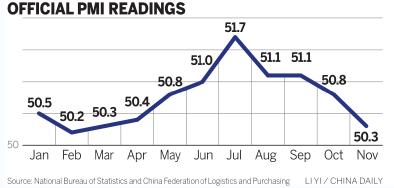
PMI declines to eight-month low; employment component weakens
Clearing the air for the Asia-Pacific Economic Cooperation forum in Beijing early last month meant closing many factories and construction sites, which left manufacturing activity almost stagnant, figures released by the National Bureau of Statistics and the China Federation of Logistics and Purchasing on Monday show.
The November manufacturing Purchasing Managers Index slipped to an eight-month low of 50.3 from 50.8 in October, the agency said.
The PMI reading signals further economic downward momentum, which is eroding the labor market and prompting policymakers to do more to stabilize growth, economists said.
According to the NBS, the output sub-index fell to 52.5 in November from 53.1 in October, and the new orders index dropped to 50.9 from 51.6.
The declines reflected excess capacity and weak demand, so factories are under rising pressure to expand output, said Zhao Qinghe, an NBS economist.
Despite the downbeat figures for November, the government has announced policies to support growth and so most enterprises are confident about the economic outlook, he said.
The PMI also showed an unfavorable situation in the labor market. The employment component eased 0.2 point to 48.2 in November. It has been below 50 since June 2012.
The PMI and its components indicate expansion if they are above 50 and contraction below that point.
Louis Kuijs, chief economist in China at the Royal Bank of Scotland Plc, said: "The domestic labor market is broadly holding up in terms of wage growth and the government's preferred indicator of new urban job growth.
"The slowdown in migrant employment growth shows that the labor market is not immune to the economic slowdown," said Kuijs. "We expect today's PMI data to add to the pressure for easing steps."
The central bank unexpectedly cut interest rates on Nov 21, and economists speculate that the latest PMI data will prompt policymakers to shift further toward supporting growth.
Kuijs forecast further steps to stimulate infrastructure investment and urbanization, as well as an additional relaxation in property market policies.
Zhu Haibin, chief economist in China at JPMorgan Chase & Co, said: "As the impact of the easing in monetary policy, together with other growth-supportive measures such as the recent easing in property sector policies and the government's further support for infrastructure investment, begins to come through, the economy's growth momentum will likely begin to turn up moderately from the second quarter of 2015."
His forecast for 2014 GDP growth is 7.4 percent, with a slide to 7.2 percent next year.
Separately on Monday, Standard Chartered Plc released its November Small and Medium-sized Enterprises Confidence Index, which rose to 58.29 from 56.64 in October, driven by a mild improvement in sales boosted by the year-end holiday season.
However, the survey also showed further deterioration in the job market, with the employment sub-index declining for the third consecutive month to a record low of 55.4.
Another sub-index measuring credit conditions at small and medium-sized enterprises climbed to 54.4 from 52.3 in October, influenced by the central bank's rate cuts, the bank said.
"Small businesses still have a cautious outlook for the first quarter of 2015, as the fundamentals for SMEs remain weak," according to economists Shen Lan and Li Wei at Standard Chartered Bank (China) Ltd.
"We expect one more rate cut in the first quarter of next year in order to lower the cost of funding and support growth."
